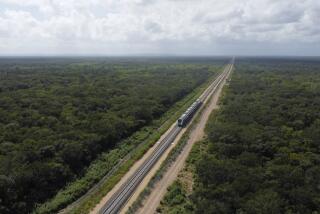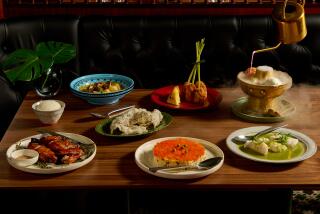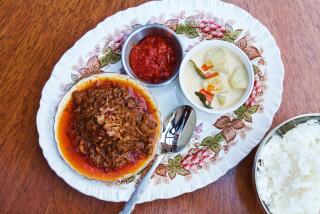‘Land Cruising’ in Style
- Share via
SINGAPORE — Traveling by luxury train down the Malay Peninsula, I discover yet another of humanity’s great divides: Some of us are rocked to sleep like innocent babes, while other poor souls suffer through nights of adult insomnia, feeling the jolt of every rail tie. I count myself among the fortunate first group.
Only the steward’s very insistent knocking on my compartment door rouses me from deep slumber. “Yeah, I remember now,” I mumble as I struggle to my feet and let him in. The evening before, I had ordered breakfast at dawn, thinking that after my usual six hours in bed, I would surely be bathed and alert by then. But I have slept for almost eight hours, and it still takes freshly squeezed juice, hot croissants, sliced tropical fruit and a few cups of steaming, rich coffee to truly revive me.
I make my way through the swaying train to the observation car at the very back. In Southeast Asia, this is the finest moment of the day. The cool, moist air rushing through the open-sided caboose leaves a tingle on my face and bare arms. The rising sun evaporates the morning mist, gently unveiling rice paddies, palm and bamboo jungles and jagged mountains. Translucent birds with names like pale-faced bulbul and fire-tufted barbet explode into panicked flight as our train rumbles by.
We pass multicolored temples and candy-striped minarets, water buffalo sunk to their hocks in lotus ponds, and peasant homes perched on stilts. Through windows illuminated by flickering bulbs, I witness a lantern-slide show of farm families on the brink of work--splashing their faces, buttoning on shirts and sipping tea.
Every minute of daylight reminds me why I’ve decided to travel through this stretch of Asia the old-fashioned--albeit upscale--way. Having once lived in this part of the world and having visited frequently over the last three decades, I realized that I had spent almost all my time here in cities and on airplanes. But despite its dash to modernization, the region has remained largely rural and traditional. It was time, I decided, to rediscover a bit of unchanging Asia at ground level.
I’m on board the Eastern & Oriental Express on a 1,200-mile journey that begins in Bangkok, plunges through southern Thailand and then Malaysia, and ends in Singapore. This is no ordinary train. Operating like a cruise ship, it takes two full days to complete the trip, making “port” stops at the River Kwai and at the island of Penang, dubbed the “Pearl of the Orient,” just off the Malaysian mainland. Passengers board for the duration and are assigned their own compartments, some large enough to be called suites, and all with private bathrooms. The food--Eurasian for the most part--merits a one-star Michelin rating. There is even after-dinner entertainment: traditional Thai and Malay dancing, a pianist belting out Cole Porter tunes in a 1920s-style bar car, and a palm reader in the library.
The passenger list reflects the hard times that have befallen Asia. There are only 50 travelers--far fewer than the 132-passenger capacity. Absent are younger Western investment bankers, many of whom lost their stock bets and then their jobs. Missing also are the Japanese, who traveled with abandon throughout the region before their economy fell into crisis. Perhaps a score of my fellow passengers are middle-aged Americans, European and Asian businesspeople and their spouses. The rest are old Asia hands, now retired but drawn back by nostalgia to the geography of an adventurous youth.
The E&O; Express--operated by the same British company that runs the legendary Venice Simplon-Orient-Express luxury train, which travels between Paris and Venice--began service six years ago and is decorated to evoke a colonial nostalgia of Asia between world wars. The exteriors of the carriages are painted in British racing green with a beige stripe, gold lettering and a crest. The passenger compartments combine inlaid woods with antique brass. One restaurant car has light-wood panels that are Thai-inspired; the other uses lacquered walls to convey a Chinese theme.
On the first day, we pull out of Bangkok’s Hualampong Station at midmorning. The terminal and the railway lines are overrun by vendors hawking food, toys and clothing. We accelerate past platforms where saffron-robed monks and whole families of Thais squat while patiently awaiting the arrival of ordinary trains connecting with the hinterland. We leave behind traffic-clogged streets, polluted air, the spider web of canals with their motorized dugouts laden with produce, the Buddhist statues and spectacular temples of the Grand Palace compound, and the mirrored skyscrapers that make the Thai capital look like a tropical Emerald City.
By the time the urban landscape yields to steamy rice paddies, we are served our first meal: a souffle of goat cheese in a lobster sauce and a pan-fried fish encrusted with sesame seeds and Asian spices. Over coffee, I ask a septuagenarian British ex-banker, traveling with his wife and two adult daughters, if the train’s decor and service inspire warm memories of his childhood and career in Asia. “There were no good old days--just a lot of poverty and heat and annoyances, for the most part,” he replies. “And there certainly weren’t any trains this comfortable.”
In the early afternoon, we make our first stop, at the River Kwai. Aboard a sightseeing boat, we pass under the infamous structure, built by Allied prisoners of the Japanese and the subject of David Lean’s acclaimed film “The Bridge on the River Kwai.” At first I’m rather skeptical of the excursion. One side of the river is lined with discos and shops, while outsize, modern weekend bungalows claim the opposite bank. But 15 minutes later, the majesty of river and rain forest and distant hills imposes itself. An elephant bathes under the watchful gaze of its driver. Village kids dive into the brown water. Boats of fishermen glide by.
We descend at a small dock and walk through a forest clearing into the flowery, landscaped cemetery where several thousand mainly British, Australian and New Zealand prisoners of war are buried, victims of disease, starvation, exhaustion and outright execution during the building of the bridge. I have visited the fields of crosses for the war dead in Europe. But what moves me so much more in this cemetery is the unexpected poetry of the epitaphs left by relatives. A.R.R. Robson, of the Royal Northumberland Fusillers, dead on Nov. 9, 1943, at age 24, is recalled by his parents: “A smiling face, a heart of gold, to us his dear memory will never grow old.” C.H. Tillett, Royal Army Service Corps, died on the same day, at age 39. Dragonflies circle over his gravestone, which reads: “Winter brings a promise of spring as wife and son to your memory cling.”
We spend the night and half of the next day crossing the northern half of Malaysia. In the afternoon, the train stops in Butterworth, and we board a ferry to the island of Penang. The population here is concentrated in Georgetown, a city whose architecture, food and faces reflect its amalgam of Chinese, Malay and Indian communities.
In Chinatown, the calligraphy above storefronts advertises antique furniture and tea sold in lacquered boxes. At the Chowrasta market, pajama-clad Chinese grandmothers scrutinize tender mustard greens and bean sprouts, ripe durian and jackfruit, fresh pomfret fish and prawns. The cool blast of air conditioners lures us from the heat into the goldsmiths’ shops on Campbell Street. Nearby, on Carnarvon Street, shops are devoted to the needs of the afterlife: the items on sale here are miniature paper replicas of cars, musical instruments and household appliances to be burnt at Chinese funerals.
Wandering down Market Street, we’re suddenly in the heart of the Indian merchant community. We bump and slide through the throngs past shops selling spices, bolts of silk and satin, and finely spun gold jewelry. On Queen Street, Hindu holy men with long beards and matted hair emerge from the Mahamariamman Temple after long hours of prayer.
I separate from the tour group and head off by bicycle-powered rickshaw for a quick visit with an architect, Laurence Loh, who is one of the leaders of a movement to preserve Georgetown’s architectural heritage. He has already helped renovate several so-called clan halls--former hostels and mutual aid societies for immigrants--to serve as schools, cultural centers and even as stages for Chinese opera performances.
We meet at Loh’s current project, the famed Cheong Fatt Tze Mansion. It was built by a 19th-century trader of such extraordinary wealth that he was dubbed “the Rockefeller of Penang.” He had hired China’s finest artisans to erect his ornate blue house in classic Mandarin style, with a huge inner courtyard and ceramic bas reliefs.
The mansion was bought a few years ago by Loh and several other young Penang architects, and is being painstakingly restored. It has been used as a movie backdrop: The gambling scenes in “Indochine,” starring Catherine Deneuve, were filmed here. Lob and his friends conduct guided tours of the house several mornings a week. A monsoon rain drenches us as we catch the ferry back to the train. A fog descends over the rubber plantations that sprawl on either side of the track. In kampongs--traditional Malay villages--children rush out of wooden houses with thatched palm roofs to gleefully wave and shout at us. Gray monkeys stare down impassively from electrical poles. It seems there is never a moment of visual monotony.
Observing the suggested dress code, I wear a blazer and tie to dinner. Some of the passengers even don tuxedos. The meal is a salmon and papaya salad.
But before turning in, I consult the palm reader. She tells me that I’m happily married, enjoy my work and have a long life ahead of me. Here is someone whose clairvoyance can evidently be trusted. With my mind at ease and some help from the rocking train, I don’t wake up until we reach the manicured suburban lawns that herald Singapore, our final destination.
(BEGIN TEXT OF INFOBOX / INFOGRAPHIC)
GUIDEBOOK
All Aboard in Asia
Getting there: A trip on the Eastern & Oriental Express can start or end in Bangkok or Singapore. There are no nonstop flights from LAX to either. To Bangkok, United, Northwest and Thai Airways offer direct flights (one stop, no plane change) beginning at $1,170 round trip. To Singapore, United and Singapore airlines have one-stop flights; round trips begin at $1,235. Cathay Pacific’s All Asia Pass--which includes round-trip economy-class service on connecting flights from Los Angeles to Hong Kong, plus 21 consecutive days of travel to any or all of 15 Asian cities--costs $999 for travel Aug. 22 through Nov. 16 (restrictions apply).
When to go: Southeast Asia is always hot and humid, but the wettest months tend to be May to October.
Taking the train: The main booking agent for the Eastern & Oriental Express in the U.S. is Abercrombie & Kent, telephone (800) 524-2420 or (630) 954-2944, fax (630) 954-3324, Internet https://www.orientexpresstrains.com. Fares for the two-night trip are $1,300 or $1,930 per person (based on double occupancy), depending on compartment. Prices include sightseeing and meals, but not drinks. Until Sept. 17, rates also include one night each in the Oriental Bangkok and Oriental Singapore hotels. The E&O; Express also makes a one-night journey to Chiang Mai, in northern Thailand; fares are $800 or $1,150.
More to Read
Sign up for The Wild
We’ll help you find the best places to hike, bike and run, as well as the perfect silent spots for meditation and yoga.
You may occasionally receive promotional content from the Los Angeles Times.






